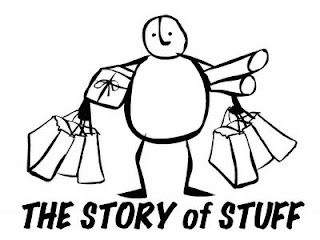 Watch the video here: Story of Stuff or here (full version). The website is here.
Watch the video here: Story of Stuff or here (full version). The website is here.For related videos, see The Corporation, Affluenza (see also its PBS website), and Consuming Kids (also their feature: 'what parents can do').
A Cautionary Video About America’s ‘Stuff’
By Leslie Kaufman, NYTimes, May 11, 2009
Excerpt:
The video was created by Annie Leonard, a former Greenpeace employee and an independent lecturer who paints a picture of how American habits result in forests being felled, mountaintops being destroyed, water being polluted and people and animals being poisoned. Ms. Leonard, who describes herself as an “unapologetic activist,” is also critical of corporations and the federal government, which she says spends too much on the military.
Ms. Leonard put the video on the Internet in December 2007. Word quickly spread among teachers, who recommended it to one another as a brief, provocative way of drawing students into a dialogue about how buying a cellphone or jeans could contribute to environmental devastation.
So far, six million people have viewed the film at its site, storyofstuff.com, and millions more have seen it on YouTube. More than 7,000 schools, churches and others have ordered a DVD version, and hundreds of teachers have written Ms. Leonard to say they have assigned students to view it on the Web.
It has also won support from independent groups that advise teachers on curriculum choices. Facing the Future, a curriculum developer for schools in all 50 states, is drafting lesson plans based on the video. And Ms. Leonard has a contract with Simon & Schuster to write a book based on the video.
The enthusiasm is not universal. In January, a school board in Missoula County, Mont., decided that screening the video treaded on academic freedom after a parent complained that its message was anticapitalist.
But many educators say the video is a boon to teachers as they struggle to address the gap in what textbooks say about the environment and what science has revealed in recent years.
“Frankly, a lot of the textbooks are awful on the subject of the environment,” said Bill Bigelow, the curriculum editor of Rethinking Schools, a quarterly magazine that has promoted “The Story of Stuff” to its subscribers and on its Web site, which reaches about 600,000 educators a month. “The one used out here in Oregon for global studies — it’s required — has only three paragraphs on climate change. So, yes, teachers are looking for alternative resources.”
Environmental education is still a young and variable field, according to Frank Niepold, the climate education coordinator at the National Oceanic and Atmospheric Administration. There are few state or local school mandates on how to teach the subject.
The agency is seeking to change that, but in the interim many teachers are developing their own lesson plans on climate change, taking some elements from established sources like the National Wildlife Federation and others from less conventional ones like “The Story of Stuff.”
Ms. Leonard is self-educated on where waste goes and worked for Greenpeace to prevent richer nations from dumping their trash in poorer ones. She produced the video, with the Free Range Studios company, and with money from numerous nonprofit groups; the largest single giver was the Tides Foundation. She did so, she said, after tiring of traveling often to present her views at philanthropic and environmental conferences. She attributes the response to the video’s simplicity.
“A lot of what’s in the film was already out there,” Ms. Leonard said, “but the style of the animation makes it easy to watch. It is a nice counterbalance to the starkness of the facts.”
No comments:
Post a Comment